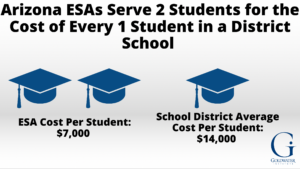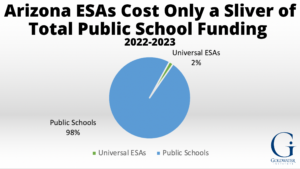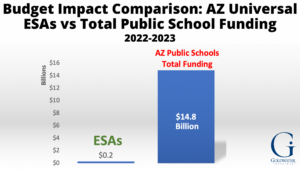First, the left told us that school choice would decimate the funding of public education. But then, Arizona passed the nation’s first universal education savings account (ESA) program last year, and funding for the state’s public schools still went up nearly a billion dollars even as tens of thousands of kids have joined the ESA program.
So now, realizing their first talking point doesn’t add up, the left has decided to switch gears: In her state of the state address, Arizona’s new governor, Katie Hobbs, (who has opposed ESAs for over a decade and recently took over for the term-limited Republican Doug Ducey) claimed earlier this month that ESAs are bankrupting not our schools, but the whole state.
It might seem odd for a progressive champion—whose transition team literally included the head of the Arizona teachers union—to suddenly warn that spending more money on education will bankrupt a state. Yet here we are, because apparently the left’s appetite for limitless spending increases on K-12 education come with a catch: that we can only afford to fund certain students—or perhaps more specifically, only students who attend certain schools.
Indeed, Hobbs and her acolytes are now complaining that the new ESAs will cost more than $1.5 billion over the next decade, and that the program has blown a hole in this year’s state budget more than $200 million dollars wide.
That all sounds awfully scary for Arizona lawmakers—or any legislators in other states considering similarly ambitious proposals. But these scare tactics are a lot less effective when met with the facts:
1) Arizona’s ESA program serves two students for the cost of every one student in a district school. Arizona’s ESA program offers awards of approximately $7,000 per child. While the program was designed to provide funding equal to “90%” of what the state funding formula would provide to public school children, that formula doesn’t include the thousands of dollars of extra funding that goes into the typical public school child’s costs—including facilities, supplemental local property tax “overrides,” federal funds, and more. That means that in practice, ESAs provide funding for each child at a rate of about half of the roughly $14,000 that is now spent on Arizona school district children (on average) each year.

Source: 2022 Arizona Superintendent’s Annual Report: District school revenues per pupil (2021-2022): $13,541, adjusted to include Arizona Joint Legislative Budget Committee (JLBC) estimated $949 increase in 2022-2023 Arizona public school funding per pupil. ESA award based on typical award for non-kindergarten, non-special needs participant.
2) The total dollar value of all new ESA awards combined adds up to less than 2% of the total cost of Arizona’s public education system. In addition to the approximately 12,000 students who were already on the ESA program before the expansion (i.e. those with special needs or meeting other specific eligibility criteria, whom even Gov. Hobbs does not propose to eliminate from the program): Approximately 35,000 new students have joined the state’s ESA program to date under the universal expansion, putting the total value of their awards in the ballpark of $240 million each year. In comparison, Arizona public schools receive roughly $15 billion per year. This means that roughly 98% of Arizona’s K-12 funding goes to public school students.

Source: Arizona JLBC K-12 Funding Report (8/31/2022): Total estimated 2022-23 funding for public schools = $14.8 B. Enrollment in Arizona universal ESA category as of January 2023: Estimated 35,000 current students X $7,000 per award = $245 million.
Even if the new universal ESA enrollment reaches 58,000 students as state budget analysts have conjectured it could by 2025, those awards will represent an amount less than 3% of total public school revenues.
Moreover, in comparison to ESA students, Arizona’s public charter schools make up over 20% of the state’s total public school enrollment and have already produced some of the nation’s most highly performing schools, such as the tuition-free Great Hearts and BASIS charter schools.
 Source: Arizona JLBC K-12 Funding Report (8/31/2022): Total estimated 2022-23 funding for public schools = $14.8 B. Enrollment in Arizona universal ESA category as of January 2023: Estimated 35,000 current students X $7,000 per award = $245 million.
Source: Arizona JLBC K-12 Funding Report (8/31/2022): Total estimated 2022-23 funding for public schools = $14.8 B. Enrollment in Arizona universal ESA category as of January 2023: Estimated 35,000 current students X $7,000 per award = $245 million.
3) The 10-year cost of funding ESAs is miniscule in comparison to the taxpayer-funded budgets of our public schools. Hobbs complained that ESAs will cost Arizona at least $1.5 billion over the next decade, yet the $15 billion annual cost of our public schools will total more than $150 billion over that same time horizon. To argue that taxpayers can afford the latter, but somehow not the former, defies basic common sense.
4) Conservative governance in Arizona has generated a budget surplus of over a billion dollars to fund ESA awards (on top of filling another billion dollars in the state’s rainy day fund). Former Governor Doug Ducey, who signed into law the state’s universal ESA program last year, was also a key architect of balancingthe state budget, taking Arizona from a $1 billion annual deficit when he took office in 2015 to a multi-billion dollar surplus.
It is true that Arizona’s ESA program, which passed in the final days of last year’s legislative session, was enacted separately from the state budget. Thus ESA award amounts were not incorporated into the projected costs for the year. But as the state’s official nonpartisan budget office has reported, the state’s revenues have also posted “an increase of $1.06 billion over the original revenue estimate included in the FY 2023 budget enacted in June 2022,” due primarily to “significantly stronger revenue growth than originally projected.”
The state has more than enough ongoing funding (in addition to its already stockpiled surplus) to maintain full funding of both the ESA program and its public schools in future years as well.
5) Students switching from public schools to ESA do not cost more For the thousands of students who switched from a public school to an ESA, state taxpayers were already paying the cost of their education. Just because the price tag now shows up in the form of an ESA award, rather than money sent to a school district, doesn’t mean it’s a new or extra cost. On the contrary, these students receive less in overall funding from state and local taxpayers than their public school peers.
6) ESAs are a net savings compared to enrolling those same students in public education. As Arizona’s Common Sense Institute recently reported, Arizona is currently spending roughly $500 million less each year than was projected in 2019 due to tens of thousands of students leaving the public school system in the wake of COVID-19. By absorbing a share of these students—rather than sending them back to a public school—the ESA program contributes to lowering taxpayers’ total tab.
7) If a state can afford to fund a student in a public school, it can just as easily afford to fund that student elsewhere. ESA opponents suggest that the program is too costly to sustain. But consider the following: No progressive advocate would seriously argue that a homeschool student should not be immediately, fully funded in a public school if that student suddenly (re)entered the public school system. But if a state can—and would—fund that child immediately upon entering the public school system, on what grounds can politicians say that child is too costly to help educate at home?
8) Public school costs not only dwarf those of the ESAs program, but also continue to pile up faster. In the coming year alone, Arizona taxpayers will be required to spend an additional $125 million for the construction costs of several new district school campuses, including in comparatively affluent communities. If our state is literally building new schools in order to accommodate our student populations, surely even ESA opponents would admit it is not a harm to offer these students a more inexpensive alternative instead.
9) Public education forces taxpayers to pay for the schooling of the ultra-wealthy, no matter how high a family’s income is, so it is completely disingenuous to oppose ESAs for allowing middle, upper, or lower-income families the same support in a private or homeschool setting.
Indeed, every state in the nation will pay for even the wealthiest family to send their child to one of its public schools—typically at a cost to taxpayers of well over $10,000 per year. Public school students in wealthier zip codes are not subject to an income test to determine whether or not they are deserving of educational support. Policymakers should not pit students against each other in private or homeschool settings based on economic factors either.
10) ESAs end the practice of double charging private and homeschool families for their children’s education. There is no justification to discriminate against private or homeschool students by withholding the financial support they would receive to attend a public school. Any family who was already in private or homeschool was voluntarily saving taxpayers money and taking on the full financial burden of their children’s education themselves. But to argue that these families’ children are now undeserving of educational assistance via an ESA program—or that providing them such assistance would be prohibitively costly—is intellectually bankrupt.
11) Arizona ESAs families are guaranteed by law to continue receiving their funding, regardless of the governor’s saber-rattling. Arizona’s new governor may have won applause from union members and opponents of education freedom by proposing to eliminate students’ newfound ESA opportunities. But thanks to the program’s inscription in Arizona state law, the governor remains powerless to take those opportunities away from them.
As Heritage Foundation scholar and former EdChoice policy director Jason Bedrick has chronicled, the left’s apocalyptic hysteria over school choice has long failed to translate prediction into reality. Now, their attempts to again cry wolf about the impact of ESAs on state budgets reflects a growing desperation. But in the end, this anti-parent platform has nothing to do with feigned fiscal prudence and owes entirely to an ideological opposition to giving families opportunities outside of the union-dominated district school system.
Indeed, as the left clamors endlessly for additional spending on public education but convulses at the prospect of directly aiding kids in other avenues, it is clear that their creed boils down to little more than a poor adaptation of George Orwell’s famous farmhouse satire: “All Students Are Equal. But Some Students are More Equal than Others.”
Matt Beienburg is the Director of Education Policy at the Goldwater Institute. He also serves as director of the institute’s Van Sittert Center for Constitutional Advocacy.





 Source: Arizona JLBC K-12 Funding
Source: Arizona JLBC K-12 Funding 






